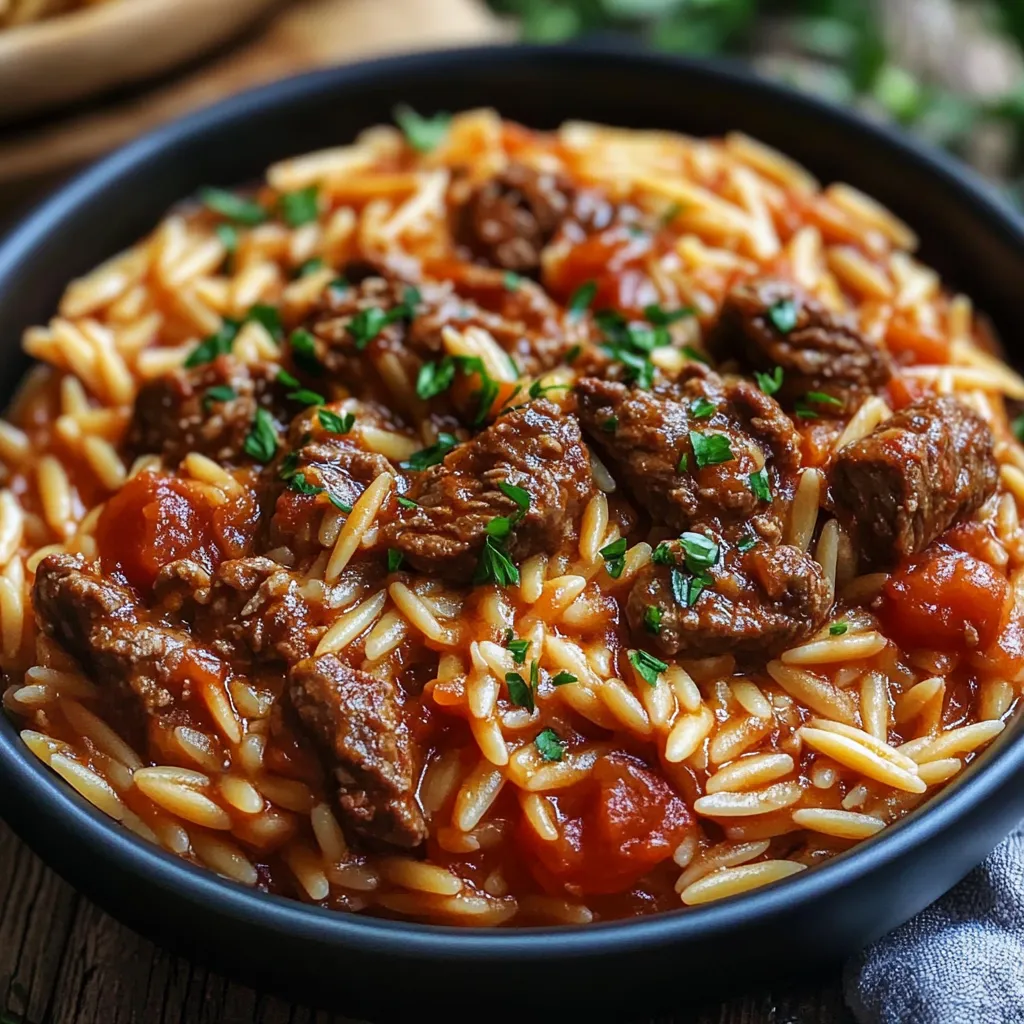 Pin it
Pin it
This rich beef Giouvetsi turns basic items into an amazing single-pot creation that's been on Greek family dinner tables for ages. When tender beef slowly cooks with fragrant herbs and finishes with smooth orzo, you get a warming meal that satisfies your hunger and warms your heart.
I first tried real Giouvetsi during a family visit to Greece where our host's grandma spent her afternoon carefully making it. Smells filled her tiny kitchen for hours before we sat at her wooden table. Now when I cook it at home, those special memories come back with every bite.
Ingredients
- Beef chuck or stew meat: These cheaper cuts get super soft during slow cooking and add rich taste to the sauce
- Olive oil: Pick a nice Greek one for real flavor and good browning
- Onion and garlic: These form the tasty base that starts the whole dish
- Crushed tomatoes and paste: Adds natural sweetness and makes the sauce thicker
- Cinnamon stick: The hidden Greek touch that brings warmth without making it taste like a sweet treat
- Allspice: Adds layers of flavor that make Greek food different from other Mediterranean cooking
- Orzo pasta: Soaks up all the tasty sauce while cooking right in the pot
- Kefalotyri cheese: Old-school Greek cheese that adds salty goodness; try Parmesan if you can't find it
Step-by-Step Instructions
- Brown the Beef:
- Add lots of salt and pepper to beef chunks before cooking in hot olive oil. Do small batches so they don't get crowded and steam instead of brown. This key step makes deep flavor and keeps juices inside the meat.
- Make the Flavor Base:
- Cook onions in the leftover beef juices until see-through and starting to brown at the edges. Throw in garlic just for the last minute since it burns fast. These veggies put their flavor into the oil before you add any liquids.
- Mix Up the Sauce:
- Cook tomato paste for a bit to get rid of any canned taste. Pour in crushed tomatoes slowly while scraping the pot bottom to get all the stuck brown bits; they're packed with flavor. Put in the cinnamon stick and allspice early so they can release their oils during the long cook time.
- Cook Until Soft:
- Keep it at a gentle simmer not a hard boil during the long cooking. Check now and then and add more broth if needed. The sauce should get thicker while the beef gets fork-tender. Don't try to rush this part.
- Add the Orzo:
- When putting in the orzo make sure it's covered with liquid so it cooks evenly. Stir often while baking to stop sticking and check if it needs more hot liquid. The pasta will soak up flavors and let out starch that makes the sauce thicker.
 Pin it
Pin it
My Greek neighbor Maria showed me why letting the beef simmer until truly soft matters; she says waiting patiently makes Giouvetsi special. When I tried to hurry it once the results weren't the same. Now I always plan ahead and let it cook slowly.
Make-Ahead Options
Giouvetsi gets better over time as flavors mix together. You can make everything until the orzo part then keep it in the fridge for up to two days. When you want to eat it, warm it gently on the stove until it bubbles before adding orzo and finishing in the oven. You might need extra broth since the sauce gets much thicker when cold.
Regional Variations
My recipe follows mainland Greek style, but some island versions throw in local herbs like oregano or even a bit of wine. In Northern Greece, they sometimes add leeks with the onions for extra sweetness. Some family recipes use lamb instead of beef especially around Easter when lamb is the traditional meat.
Serving Suggestions
Bring Giouvetsi to the table in its cooking pot for a homey feel. Serve with a simple Greek salad topped with good olive oil and red wine vinegar. Crusty bread is a must for soaking up every drop of the amazing sauce. A glass of medium-bodied red wine, particularly a Greek Agiorgitiko, makes the meal complete.
 Pin it
Pin it
Share this filling and cozy dish with your family and friends—it's food that's meant to be enjoyed slowly!
Frequently Asked Questions
- → What cut of beef works best for Giouvetsi?
Chuck or stew meat work great for Giouvetsi because they get super tender and full of flavor when cooked for a long time. These tougher pieces break down really well during slow cooking, turning into melt-in-your-mouth meat that makes the sauce extra rich.
- → Can I make Beef Giouvetsi in advance?
You can totally make this a day before. Just cook the beef and sauce all the way, then pop it in the fridge. When you're ready to eat, warm up the beef mix, throw in the orzo and finish cooking. The dish actually tastes even better this way because the spices have more time to mix together.
- → What can I substitute for orzo pasta?
If you can't find orzo, try small pasta shapes like risoni, tiny shells, or even plain rice. Greeks sometimes call it kritharaki, which is just their name for orzo. Just remember your cooking time might need to change a bit depending on what you pick instead.
- → Is Kefalotyri cheese necessary for authentic flavor?
Kefalotyri cheese gives you the most authentic taste, but it's hard to find outside Greece. You can swap in Parmesan, Pecorino Romano, or Mizithra instead. Any hard, salty cheese you can grate will do the trick and match well with all the other flavors.
- → Can Beef Giouvetsi be made in a slow cooker?
This dish works great in a slow cooker. Brown your beef and cook your aromatics first, then dump everything except the orzo into your slow cooker. Let it go on low for 6-8 hours until the beef feels tender. Add your orzo for the last 30-40 minutes, or cook it on the side and mix it in when you're ready to eat.
- → How do I know when the orzo is perfectly cooked?
Your orzo should feel soft but still have a tiny bit of bite to it. In this dish, the orzo keeps soaking up liquid even after cooking, so you want to stop when it's just gotten tender. If things look too dry while cooking, just splash in some hot broth as needed.
